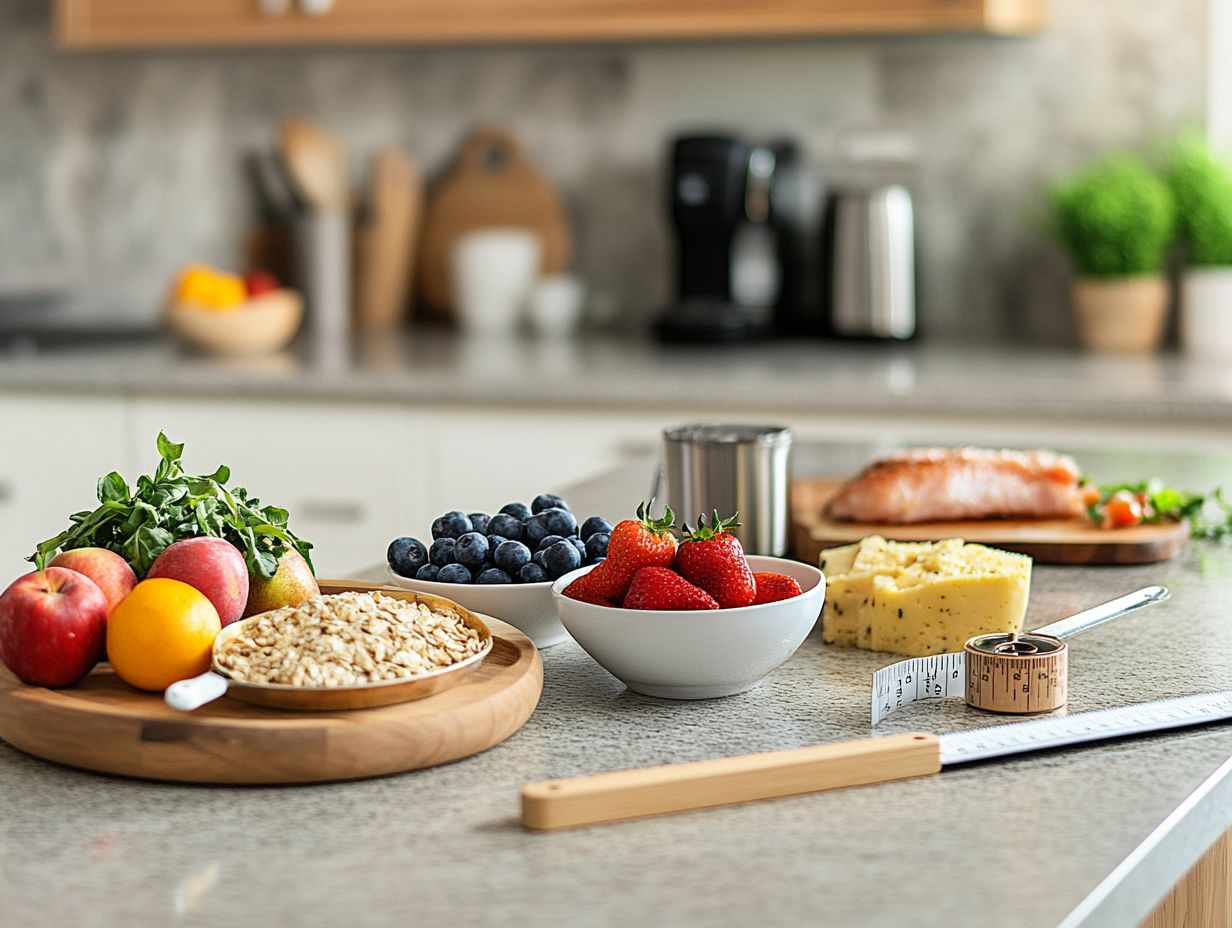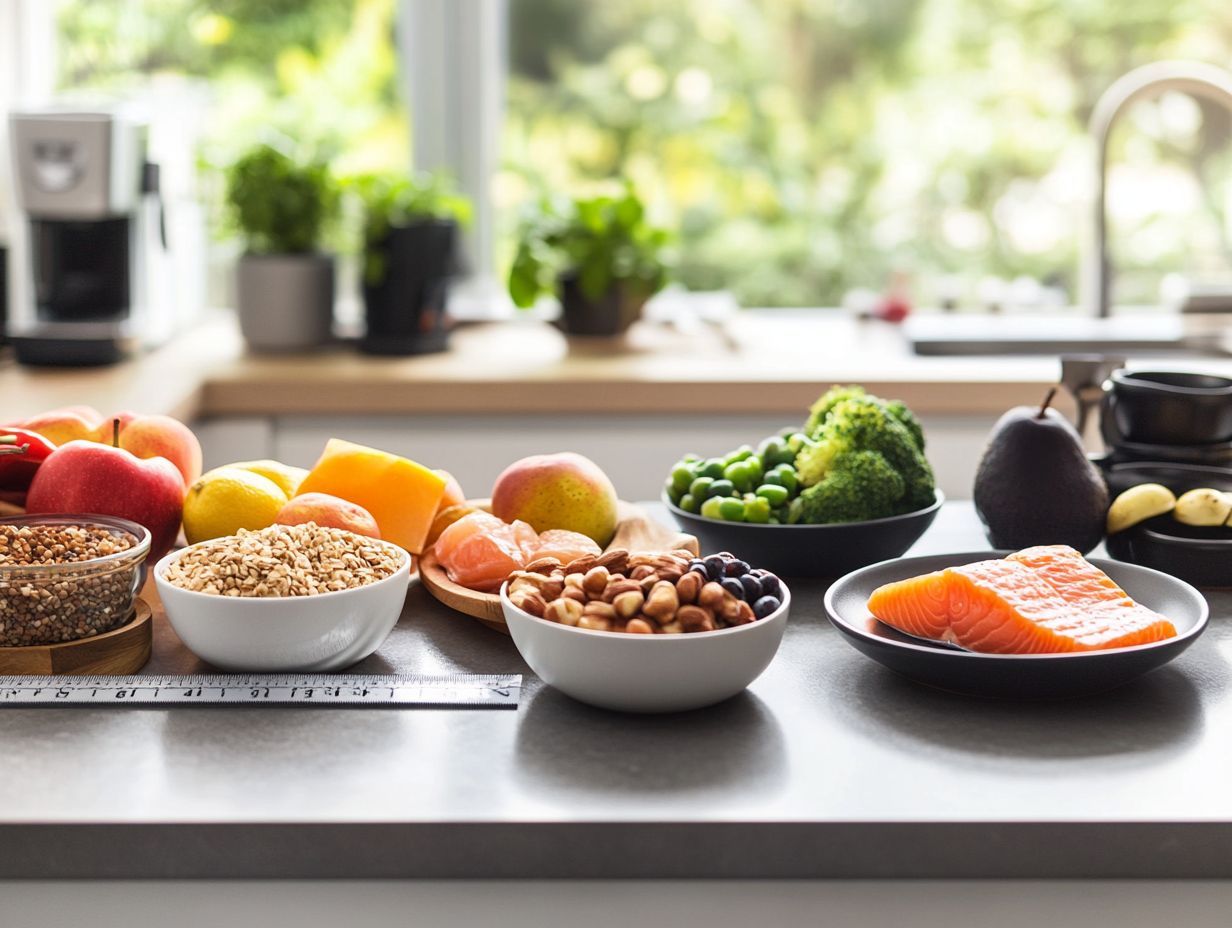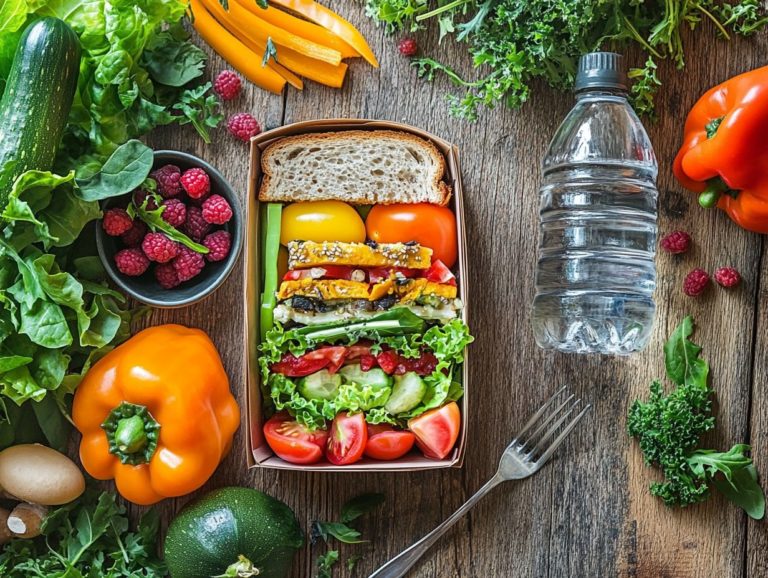Understanding Serving Sizes for Better Eating
Grasping serving sizes is key to making smart food choices and living healthier. Understanding serving sizes is crucial for maintaining a balanced diet and controlling calorie intake.
This article delves into the definition and significance of serving sizes. It examines how they affect calorie intake and their important role in planning balanced meals.
You will find practical tips on how to determine proper serving sizes using food labels and measurements. We will clear up common misunderstandings and explore strategies for controlling portions.
By mastering these concepts, you can take control of your nutrition and make healthier eating decisions that truly benefit your well-being.
Contents
- Key Takeaways:
- What are Serving Sizes?
- The Role of Serving Sizes in Nutrition
- Using Serving Sizes to Plan Balanced Meals
- How to Determine Serving Sizes
- Reading Food Labels
- Measuring Portions
- Common Misconceptions About Serving Sizes
- Tips for Controlling Serving Sizes
- Frequently Asked Questions
- What are serving sizes and why are they important for better eating?
- How can I measure serving sizes for my meals easily?
- What is the difference between serving size and portion size?
- How do serving sizes differ for different food groups?
- Are serving sizes the same for everyone?
- What are some tips for better understanding serving sizes?
Key Takeaways:

Understanding serving sizes is crucial for maintaining a balanced diet and controlling calorie intake. Food labels and portion measuring can help determine correct serving sizes, avoiding portion distortion and clearing up common misunderstandings. Strategies such as portion control and healthy swaps can aid in managing serving sizes and promoting healthier eating habits.
What are Serving Sizes?
Serving sizes are pivotal in your journey toward understanding nutrition and embracing healthy eating. They dictate how much food you consume in a single meal. This plays a key role in managing your calorie intake, ensuring your meals are balanced, and guiding you toward making healthier food choices.
The FDA states that adhering to proper serving sizes can significantly aid in tracking your food portions. This will help you maintain a diet that aligns with the Dietary Guidelines for Americans (recommended food and activity guidelines). Learning about serving sizes lets you control your appetite better and make informed decisions about the food you choose, whether at home or dining out.
Mastering this knowledge is essential for kickstarting your journey to a healthier lifestyle and preventing obesity.
The Role of Serving Sizes in Nutrition
Serving sizes play a crucial role in understanding nutrition, as they directly impact your calorie intake and overall dietary habits.
By adhering to recommended serving sizes, you enable yourself to make informed choices that lead to a balanced diet, brimming with fruits, vegetables, and whole grains.
This knowledge is especially important if you’re aiming to manage your weight or prevent obesity. It allows you to track your food portions more effectively, whether you’re at home or dining out.
Serving sizes help you understand the nutritional value presented on food labels. This enables you to align your eating patterns with your health goals.
How Serving Sizes Affect Calorie Intake
Understanding how serving sizes impact your calorie intake is essential if you want to manage your weight and maintain a healthy diet. Serving sizes dictate how much food you consume, and consequently, how many calories you take in at each meal.
When you re not aware of proper serving sizes, you run the risk of overeating, leading to excessive calorie consumption and potential weight gain. This is particularly common with prepackaged foods or restaurant meals, where portion sizes often exceed recommended guidelines.
By being mindful of serving sizes, you can better regulate your calorie consumption and make healthier eating choices.
For instance, a typical serving of pasta is about one cup, which contains approximately 200 calories. However, many people unknowingly serve themselves two or three cups. Similarly, the standard serving for nuts is just a handful, equating to around 150 calories. Yet it s all too easy to munch mindlessly from a large container.
Grasping these guidelines enables you to portion your meals appropriately. This leads to better choices that align with your dietary goals. Portion control not only aids in weight management but also encourages a well-rounded intake of nutrients, emphasizing the importance of moderation in maintaining your overall health.
Using Serving Sizes to Plan Balanced Meals
Using serving sizes to plan balanced meals is a smart strategy for maintaining a healthy eating regimen that meets your nutritional needs. A well-balanced meal includes a variety of food groups, such as fruits, vegetables, grains, and proteins, all portioned according to serving size recommendations.
By following the serving sizes outlined in the USDA’s MyPlate Plan a guide to healthy eating you can ensure you receive adequate nutrients while managing your calorie intake effectively. This practice supports weight maintenance and enhances your overall health and well-being.
To create meals that align with these guidelines, visualize your plate divided into sections. Allocate half for fruits and vegetables, while the other half can be filled with proteins and grains.
For instance, use a measuring cup or a food scale to get familiar with appropriate serving sizes. This can help you avoid overserving!
Incorporating seasonal produce into your meals adds variety and tantalizes your taste buds. Choosing whole grains over refined options promotes better health. Using a food diary can help track your food choices effectively.
This approach encourages mindfulness about your food choices and helps you manage portion sizes.
How to Determine Serving Sizes

Determining serving sizes requires good knowledge of food labels and accurate measurement of portions. This ensures you consume ideal amounts for optimal nutrition.
Food labels are your allies! They offer essential details about serving sizes, calorie counts, and recommended portions, guiding you toward healthier choices.
Using measuring tools like cups and spoons, along with visual references, can enhance your ability to control portion sizes in your kitchen.
Master these techniques to track your food intake effectively and align your meals with your dietary goals.
Reading Food Labels
Reading food labels is essential for anyone looking to understand serving sizes and make informed dietary choices. Typically, food labels feature a Nutrition Facts panel that specifies the serving size, calories, total fat, and nutrient content.
Familiarizing yourself with these labels helps you track calorie intake and stick to recommended portion sizes. This practice aids in meal planning and enables you to make healthier choices.
Interpreting the serving size is vital. Many products contain multiple servings in one package. For instance, if the serving size is half a cup, munching through an entire bag could significantly boost your calorie intake.
Understanding that a product is rich in fiber or protein might lead you to choose it over a less nutritious option. This awareness encourages thoughtful decisions that align with your health goals, paving the way for a balanced diet.
Measuring Portions
Measuring portions accurately is essential for effective portion control and managing calorie intake. Using cups, food scales, or visual comparisons ensures you consume the right amounts to meet your dietary goals.
This practice is beneficial when preparing meals or snacking, as it helps you avoid unintentional overeating. Mastering portion measurement fosters healthier eating habits and greater awareness of your food consumption.
Using measuring cups for liquids and solids is a straightforward starting point. You can also explore portion control methods, like the hand technique, to gauge serving sizes based on your palm, fist, or thumb.
Investing in a digital kitchen scale provides precise measurements, especially for tricky items like nuts or grains. Keeping a food diary or using calorie-tracking apps enhances your accuracy, helping you visualize your intake and make adjustments.
Ultimately, accurate portion measurement aids in maintaining a balanced diet, promotes mindful eating, and supports your overall health by keeping your calorie counts in check!
Start measuring your portions today to see the difference!
Common Misconceptions About Serving Sizes
Common misconceptions about serving sizes can lead to misunderstandings of your nutritional needs. This can foster unhealthy eating habits.
One significant issue is portion distortion. This means thinking you eat less than you actually do compared to standard sizes. It can lead to excessive calorie intake and contribute to weight gain or obesity.
By debunking these myths and learning about proper serving sizes, you can enhance your nutrition. This helps you make healthier food choices.
Portion Distortion and Serving Size Myths
Portion distortion misrepresents the actual serving sizes recommended for healthy eating. You might mistakenly think that larger portions are acceptable, leading to consuming excess calories.
This misunderstanding can seriously impact your health, contributing to obesity and other diet-related issues. Recognizing true serving size guidelines helps you take steps toward healthier eating habits.
Research shows that portion sizes in restaurants and at home have dramatically expanded. The average entr e has increased by nearly 300% in some cases. This normalization of larger servings can perpetuate overeating.
This trend creates a gap between perceived normal sizes and what is actually recommended. Understanding standard portions can revolutionize your dietary choices.
You must familiarize yourself with appropriate servings of vegetables, grains, and proteins. This knowledge promotes better nutritional habits and supports your overall well-being.
Tips for Controlling Serving Sizes

Controlling serving sizes is crucial for effective weight management. Practical tips can transform how you approach your meals.
Use smaller plates and measure food portions. Practicing mindfulness while eating also aids in maintaining appropriate serving sizes.
Planning your meals in advance bolsters your balanced nutrition. Embrace these practices to refine your portion control and elevate your dietary choices.
Portion Control Strategies
Implementing effective portion control strategies is essential for maintaining a healthy diet. Measure portions before serving and use smaller dishes to influence your calorie intake.
Using tools like food scales and measuring cups enhances accuracy in portion sizes. This promotes healthier eating patterns.
At home, practice mindful eating by serving food from the kitchen. This helps resist second servings. When dining out, choose smaller plates or share meals. Many restaurants offer half portions or tapas-style options to savor flavors without extra calories.
Incorporate visual cues, like filling half your plate with vegetables. This leads to smarter portion choices, making meals satisfying and nutritious. A balanced approach allows you to enjoy your meals while aligning with your health goals.
Healthy Swaps for Larger Portions
Making healthy swaps for larger portions can significantly enhance your overall nutrition while allowing you to enjoy satisfying meals. By swapping out unhealthy ingredients for healthier options, you can reduce your calorie intake without compromising on flavor.
Try swapping out white rice for quinoa it’s not just healthy, it’s delicious! You can also use vegetables instead of pasta; these alternatives provide great volume and nutritional benefits.
Plus, think about incorporating cauliflower rice into your meals. It’s low in carbohydrates yet packed with fiber and vitamins.
When it comes to sauces, consider choosing Greek yogurt instead of sour cream. This simple swap can elevate your protein intake while cutting down on unhealthy fats.
Replacing sugary beverages with infused water or herbal teas can dramatically decrease your calorie consumption while still delivering refreshing flavors.
Each of these alternatives encourages you to experiment with new ingredients, ultimately leading to healthier eating habits and more nutritious choices. Don’t miss out on these tasty options that can completely transform your meals!
Frequently Asked Questions
What are serving sizes and why are they important for better eating?
Serving sizes refer to the recommended amount of a food or beverage that is considered to be one serving. They are important for better eating because they help with portion control and ensure that you are not overeating.
How can I measure serving sizes for my meals easily?
You can measure serving sizes with cups, spoons, or a food scale. Pay attention to the serving size information on nutrition labels, as it may help you avoid overeating.
It’s also essential to note the number of servings in a container, as it may not always be just one.
What is the difference between serving size and portion size?
Serving size is a standardized measurement recommended for a specific food, while portion size refers to the amount of food you choose to eat at one time. Serving sizes help you maintain better eating habits, while portion sizes may vary and require more attention.
How do serving sizes differ for different food groups?
Serving sizes can vary for different food groups depending on their nutritional content. For instance, a serving size for vegetables is typically larger than that for proteins or grains.
Following recommended serving sizes for each food group is crucial for ensuring a balanced and nutritious diet.
Are serving sizes the same for everyone?
Serving sizes are generally based on the needs of an average adult, but they may differ for individuals based on factors such as age, gender, and activity level. It’s important to adjust your serving sizes according to your individual needs and goals.
What are some tips for better understanding serving sizes?
Pay attention to recommended serving sizes on food labels. Measure your food using measuring tools, and use your hand as a quick guide for portion sizes. For example, one serving of protein is about the size of your palm.
Also, familiarize yourself with common serving sizes for different food groups to help with portion control.






